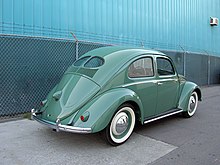This article has multiple issues. Please help improve it or discuss these issues on the talk page. (Learn how and when to remove these messages)
|
Conservation and restoration of road vehicles is the process of restoring a vehicle back to its original working condition. Vehicles, whether partially scrapped or completely totaled, are typically restored to maintain their roadworthiness or to preserve those with antique status for use as showpieces.
Bus preservation groups aim to purchase buses of various eras to restore them to their original operating condition. Buses are often restored to the original authentic livery of their original owner.

Restoration means removing, replacing, or repairing the parts of a vehicle, while preservation means keeping the original components. Though automotive restoration is commonly defined as the reconditioning of a vehicle "from original condition in an effort to return it to like-new or better condition,"[1] There are many styles of which a vehicle can be restored, any of which can be performed at the discretion, desire, or taste of a vehicle owner or restorer.
There are different levels of automotive repair. The highest quality level, generally unobtainable for the amateur restorer, is the Concours d'Elegance level; these are cars that are frequently restomoded to a degree often beyond the quality that they were when they left the factory. There are virtually no deficiencies in the quality of the parts that were actually restored. Those parts that did not come on the car as it was first sold must have the highest level of fit and finish, and appear to have been original parts. Many Concours cars are not driven except for the short distances from their trailers to the show field. For example, the guidelines of the Antique Automobile Club of America (AACA) are to "evaluate an antique vehicle, which has been restored to the same state as the dealer could have prepared the vehicle for delivery to the customer."[2] Only when a car is completely placed back into the condition it was first sold in is it considered to be restored. Various aspects of a car may be repaired without the car being restored. A car that does not run can be repaired to running condition, but that simply means it will now run and does not mean that any part of the car has been restored. Automotive Restoration means that the car was put back into the condition it was first sold as. Anything else is either repair or resto-mod. Between these two extremes are the vast bulk of cars that are seen as drivers, neighborhood show cars, and 20-footers—in that they look great from 20 feet (6 m) away. Many value guides offer six levels of quality, from a "parts-only" car to the best at "Number 1"—absolutely perfect in every way.
A full car restoration can take many years and can cost tens of thousands of dollars,[3] often well in excess of what the finished value of the car will be. Many jobs will have to be farmed out to specialty shops—those with the special knowledge and equipment to do the job. Often a restoration once started is left unfinished and the car and parts can be purchased for a fraction of their worth. However, if a person buys an unfinished project, it is imperative to be sure that all of the parts are there. Finding parts for an orphan or rare car can sometimes be impossible. This necessitates the fabrication of parts from scratch, generally at great effort and expense.
There are help sources, books, and magazines (Skinned Knuckles in the US or Practical Classics in the UK, for example) to assist with restoration of an entire car or specific parts.
- ^ "Learn Auction Terminology, Be A Step Ahead". barrett-jackson. 7 June 2011. Retrieved 12 September 2015.
- ^ "Official Judging Guidelines" (PDF). Antique Automobile Club of America. 2014. Retrieved 12 September 2015.
- ^ "Where Does the Time and the Money Go?". popularrestorations.com. Archived from the original on 23 April 2011. Retrieved 2011-04-22.